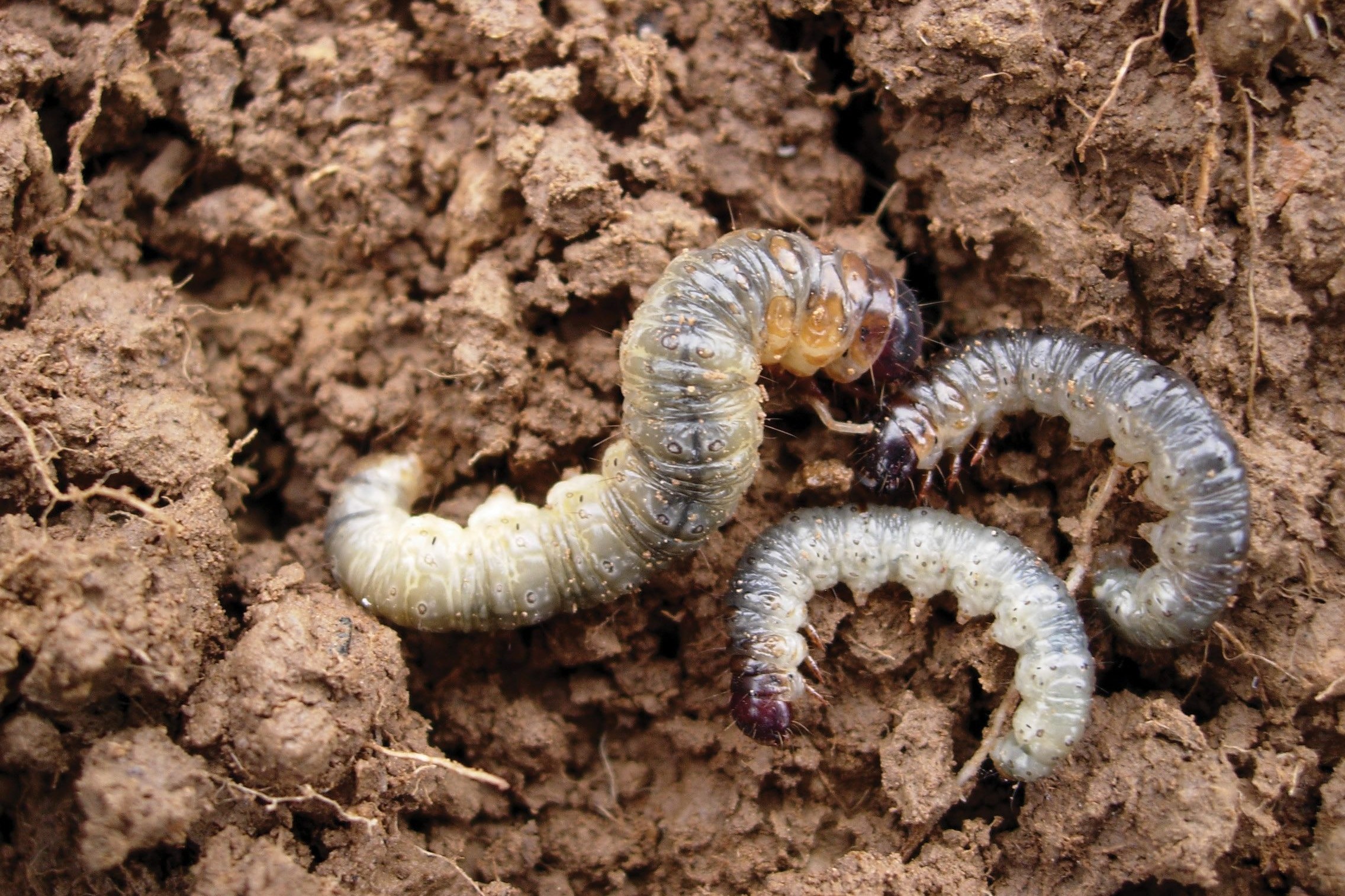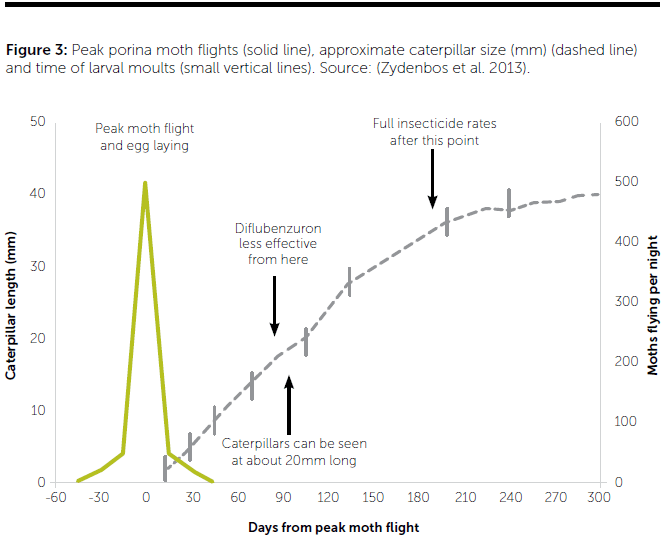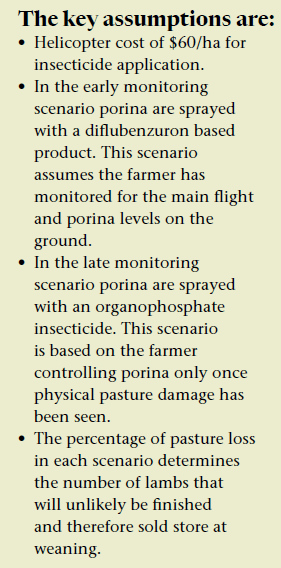Early bird gets the worm
Morgan Inness reports on the benefit of monitoring for porina.

Morgan Inness reports on the benefit of monitoring for porina.
Pasture damage from porina seen by many farmers around the country this winter and spring, has no doubt raised the question of “why was it so bad this year?”
Many farmers have sprayed too late or have not sprayed large enough areas of their farms and have seen severe pasture damage. It helps to have some basic understanding of the biology, life cycle and benefits of monitoring for controlling porina.
Porina is the common name for a group of moths and caterpillars found in New Zealand, some of which significantly affect pasture production and plant composition in our pastures.
All porina species have one generation per year; however, different species fly at different times. There are typically one to three main flight periods per season depending on location. Generally the South Island locations experience a later spring and a mid-summer main flight. Many North Island areas have a main flight in later summer to early autumn but these timings can vary.
The moths themselves do not feed and only live for a few days. However, females will lay several thousand eggs during this time. Eggs are jettisoned by females during flights over several hundred metres. Eggs typically take three to six week to hatch depending on the temperature, and at higher temperatures eggs will hatch faster (above 25C the eggs will die).
Pasture damage starts to occur when the newly hatched caterpillars living on the top of the soil in leaf litter and at plant bases start to feed on surrounding plant matter. As they grow they start to construct burrows into the soil that can reach 30cm deep. At this stage caterpillars will emerge from their burrows at night and feed on leaves close to ground level and take them down into the burrow. Their reluctance to move far from their burrows consequently kills plant crowns opening bare patches within pastures.

Pathogen control
Porina numbers are strongly affected by naturally occurring pathogens in pasture. In a stable environment such as tussock grasslands or old pastures, these pathogens tend to regulate porina populations so numbers are low (less than 15/square metres).
Many pathogens found in pastures are dependent on porina, so caterpillars must be present in sufficient but not damaging numbers. When this interaction between pathogen and porina numbers is disrupted by drought, cultivation, or application of some insecticides a damaging outbreak of porina is likely. Typically, these outbreaks will occur two-four years after a disruption event.
Porina are grazers at low densities (20-40/sq m) but are denuders at higher densities (40+/sq m). At low densities, porina will consume an equivalent to one ewe with a lamb (one stock unit). However at higher densities the amount of pasture consumed by porina can be a lot more costly. It has been estimated that the loss in pasture area from one caterpillar is 50 square cm (Ferguson et al. 2019).
Figure 1 shows a pasture recovering from severe porina damage. While hard to see in the image, the re-growing pasture species are predominantly weeds. As a result the productivity of this pasture has been dramatically reduced.
Not only has the direct loss in pasture cost the farmer through reduced feed intakes, there is either an additional cost to regrass and get the pasture back to a productive state or a longer ongoing loss of productivity.
As Figure 2 shows, the damage caused by porina when populations increase above 40/m2 can have a dramatic effect on a farm business’s bottom line. Therefore monitoring and implementing mitigation strategies is key to reducing the economic impact of porina.

Monitoring
The most important factor in dealing with porina is monitoring from when the main flights occur. It should be noted different species can fly at different times so continued monitoring over the late spring, summer and autumn period is key depending on your location. Peak flights are very obvious; an outside light will attract moths in large numbers and often observing this is all that is needed to recognise them.
It is recommended that at risk pastures should be sampled eight-12 weeks after the peak flight. An at risk pasture can be defined as:
- A new pasture which is under four years old.
- A long pasture which has been saved for feeding in the autumn/winter.
At eight weeks, caterpillars are just 10-15mm long so searching has to be thorough. However the majority of caterpillars will be either on the soil surface or 3-4cm deep at most. Between
12-16 weeks post-flight, digging should be between 5-15cm and after 16 weeks at 20-25cm deep. It is best practice to do at least 10 representative holes per pasture.
As Figure 3 shows, eggs start to hatch from two-three weeks after peak moth flight. From this point until week 12 it is highly recommended that diflubenzuron, insect growth regulator that prevents the larvae from moulting, is used. At this stage, caterpillars are small, meaning they are causing little to no damage, they are on or near the soil surface and moulting frequently, which allows diflubenzuron to work effectively.
Diflubenzuron is relatively safe for users and many non–target insects, and it usually leaves sufficient porina in pastures to allow the persistence of naturally occurring pathogens that suppress any residual population.
This insecticide is also considerably cheaper than the organophosphate insecticide option. The price for diflubenzuron is $19/ha, compared to organophosphate insecticides $48/ha, plus application costs.
After week 12 from peak moth flight, organophosphate insecticides are the only option to controlling porina populations. This is often the most common option for farmers as it requires less knowledge about pest development but unfortunately has a wider negative environmental impact and greater safety risks.

Financial analysis of monitoring
The time and effort it takes to monitor porina levels is often overlooked by many farmers and therefore a reactive approach is often taken to control porina after the pasture damage has been seen. The financial analysis in Table 1 demonstrates the financial impact of either leaving the monitoring of porina late or not monitoring at all compared to monitoring early.
The financial analysis represents a theoretical central North Island farm which is typically one of the areas in NZ that can be badly affected by porina outbreaks. This analysis is based on the time period from lambing to weaning. However it should be noted that the effects of porina will also have a financial cost both before lambing and after weaning. The main flight event would have occurred during the prior summer or autumn.
It should be noted that pasture loss was calculated using the pasture area eaten by one caterpillar of 50sq cm.
As Table 1 shows, monitoring early for porina can greatly reduce its impact on farm profitability with a 10% reduction in profit relative to a non-flight year compared to a 28% and 54% reduction in profit if monitoring late or not monitoring at all.
The true cost of porina on a farm’s profitability would likely be much higher than the figures in Table 1, with the additional loss of feed before lambing (winter) and particularly after weaning potentially impacting on ewe body condition.
While the appearance of porina on the farm will invariably result in some profit erosion, proactive monitoring will allow for less-expensive intervention and lower pasture damage. When it comes to porina management, the early bird really does get the worm.
- Morgan Inness is a consultant with Perrin Ag.





